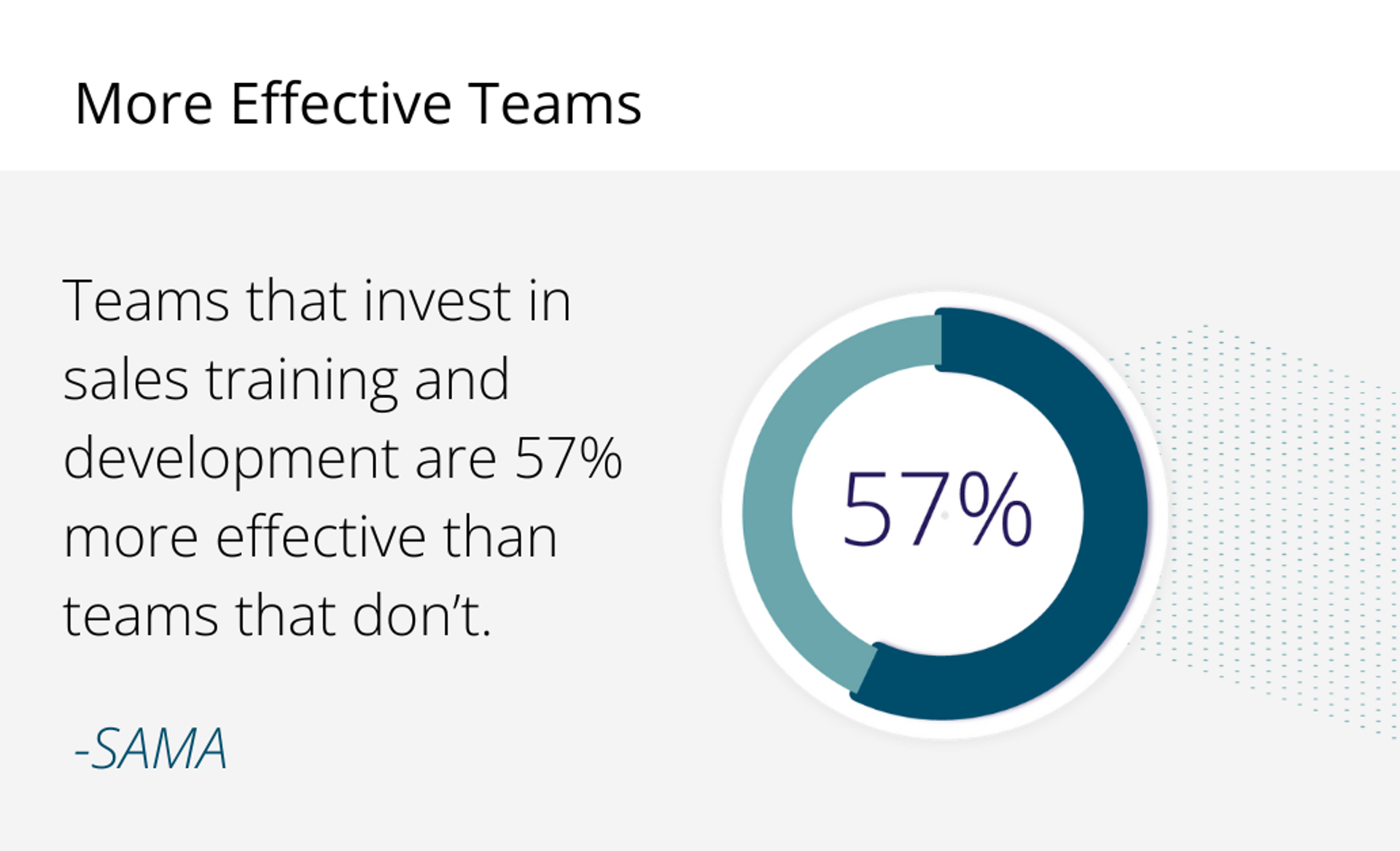How Much Does Sales Training Cost?
Sales performance improvement

For many years, HR and Talent executives invested in training and developing their teams. Training provided clear value that these executives rarely questioned.
Then came the Great Recession and everything changed. Companies scrutinised every investment and the cost of sales training became more of a consideration. Companies scaled back all possible expenditures. Training investments diminished.
Eventually, the economic recovery took hold. With cost avoidance measures exhausted, productivity maximised, and acquisitions prohibitively expensive, executives seeking competitive advantages renewed their focus on sales skills training for employees.
Gaining Buy-In for Investment
Getting the support and buy-in for putting people in the classroom today is not as easy as it used to be. Nor should it be.
A decision to move people from the field to the classroom requires a meaningful ROI. Moreover, leaders need assurance that the return exceeds what they can expect from other investment options. They need to know that it will yield benefits within the timeframe established by the critical stakeholders.
At Richardson Sales Performance, we understand the immediate value that can be created when your customer-facing teams change how they interact with buyers. Yet, all too often, the analysis around the true cost of sales training misses the mark.
How Much Does Sales Training Cost?
Investing (or not investing) in sales training can cost your company more than you realise. It's not just the monetary value associated with the course or programme. Research from the Strategic Account Management Association (SAMA) shows that teams that invest in sales training perform better overall. In fact, these sales teams are 57% more effective than those that do not.

Additionally, research from McKinsey states that 87% of companies are aware that they have a skills gap, or will have one within a few years. Recognising the cost of a skill plateau or the benefits of improving performance helps decide whether a sales training programme is worth the investment. This insight forms the foundation for making an informed decision.
However, at a surface level, the cost range for sales training is almost impossible to determine. Multiple factors affect the price, starting with your company's needs and wants. For instance, larger companies may need more in-depth training programmes that can scale across all parts of the organisation. They may also rely more on CRM integration technology.
A small company or start-up may want something less comprehensive. They may seek alternative solutions like Youtube videos, publications, or other simpler solutions. These solutions can seem appealing due to their low price point. However, to truly be successful, sellers need a structured sales methodology. For example, Richardson utilises the Sprint Selling methodology.

Other factors that affect cost are the timeline, the number of trainers needed, the number of training days, and the amount of people taking the training. Are you looking for online, or in-person, or hybrid training? Determining these factors helps to identify the right type of sales training for your company.
In this video, Richardson Sales Performance President & CEO, John Elsey, breaks down the cost of sales training. He explains the equation for this investment using three simple variables:
- Explicit Cost
- Implied Cost
- Benefit Realisation
To learn more about the true cost of sales training contact us today to speak with a member of our team.
Explicit Costs
Explicit costs are those incurred when training design, development, and delivery are sourced from a third-party provider.
More than anything else, these are easiest to understand and influence (based on scope). As such, these costs typically get the most attention in the economic analysis.
Purchasers spend considerable time seeking strategies to drive down explicit costs. A well-run procurement process is important, but it does not greatly impact the overall cost of training.
Why? Because our next two variables have an exponential effect that outweighs any pluses and minuses here.
Implied Costs
Implied costs often run at three times or more than explicit costs.
Sales reps are quota-bearing, expensive, and often distributed across a variety of areas locally or globally. With this in mind, you need to carefully consider the cost of taking your sales professionals out of the field for training.
These factors determine lost productivity costs. Examples include easy-to-measure costs, such as travel and accommodation for both sales professionals and sales management.
To further understand what is at stake, you need to understand the contribution by rep per day. This builds into the cost side of the equation when determining to adopt a selling programme.
At Richardson Sales Performance, we minimise time out-of-market. Instead, we build skills by combining instructor-led classroom learning with mobile-optimised digital learning programmes. This dual approach offers efficacy and cost efficiency.

Customised Sales Training Programs: Elevate Your Team's Performance
Our industry-leading approach to customisation ensures your training programme is relevant to your seller's world. Making lessons learned in training immediately effective in the field.
Learn MoreBenefit Realisation
This is why you train, right? Often, we neglect the other side of the training balance sheet. Leaders must quantify the benefit expected, with a reasonable degree of confidence, for a number of reasons including:
- Unless you understand the economic impact of how changes in customer-facing behaviour influence critical operational metrics, your analysis will only ever be one-sided. The case for training will likely never pass the common-sense test.
- The act of working through understanding the economic impact of sales training drives consensus with stakeholders on what you hope to achieve and how you know that you have achieved a successful outcome when it happens. Without this step in the process, most training initiatives will falter as time passes.
- Critical Selling Metrics across three dimensions (operational, talent, and financial), such as Average Sale Price, Time to Revenue, and Reps at Quota, allow you to create a financial model and calculate return based on a range of outcomes anticipated. You should expect your training provider to help you build these financial models based on results that they have delivered with similar clients in comparable industries.
- Just as Implied Costs significantly outweigh Explicit Costs, so too should the value of improved operational metrics significantly outweigh the cost side of the equation. These costs are the hardest to defend, and therefore need to withstand discounting by skeptical stakeholders and still leave a credible and powerful argument in place.
Never anchor your economic analysis or your assessment of the cost of sales training for your organisation to one data point. Rather, develop a financial analysis that simulates a range of outcomes based on the cost and benefit variables.
This approach engages stakeholders in a discussion on the variables. Through a series of likely iterations on your model, it also builds consensus and buy-in.
Results will vary of course. At Richardson Sales Performance, we’ve seen an average revenue gain of 5-12 percent per annum across our clients. For one client, that translated into a 22:1 ROI.
Measurable gains like this come from our customised training programmes, built on our science-backed sales methodology. Within our methodology, we've developed a diverse set of sales training capabilities. These enable sales reps to stay agile amidst changing markets and increased customer demands. Results from these trainings underpin the meaningful, long-term value of taking a little time to step off the field and review the playbook.
At Richardson, our approach to sales training has impacted over 900 clients worldwide. Learn how our clients saw an increase in revenue, skill efficiency, and knowledge proficiency by reading our case studies.
Still trying to figure out the best path for your company? Reach out today to set up a meeting with one of our skilled reps to discuss options and pricing.

Brief: The Economics of Sales Training
DownloadGet industry insights and stay up to date, subscribe to our newsletter.
Joining our community gives you access to weekly thought leadership to help guide your planning for a training initiative, inform your sales strategy, and most importantly, improve your team's performance.






